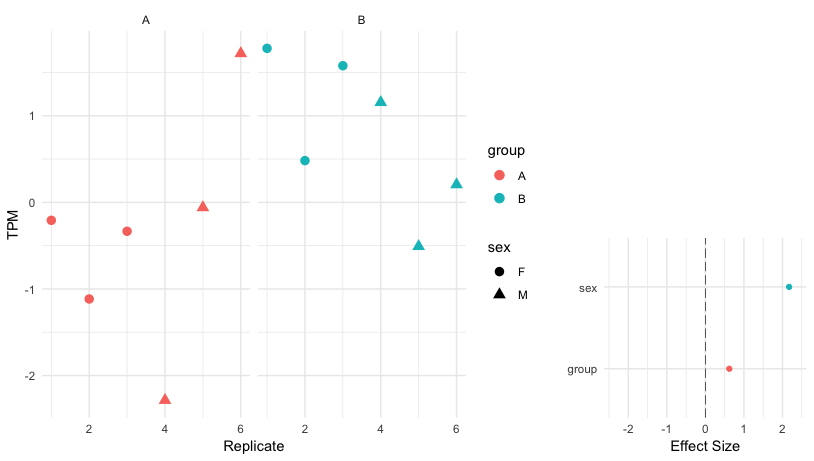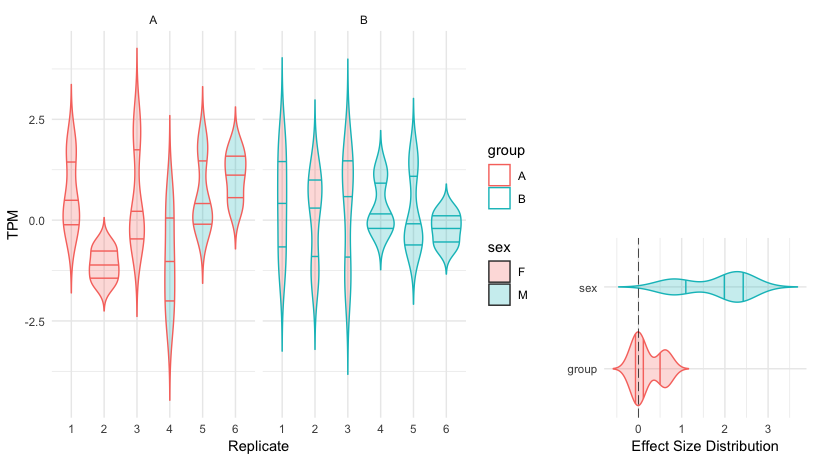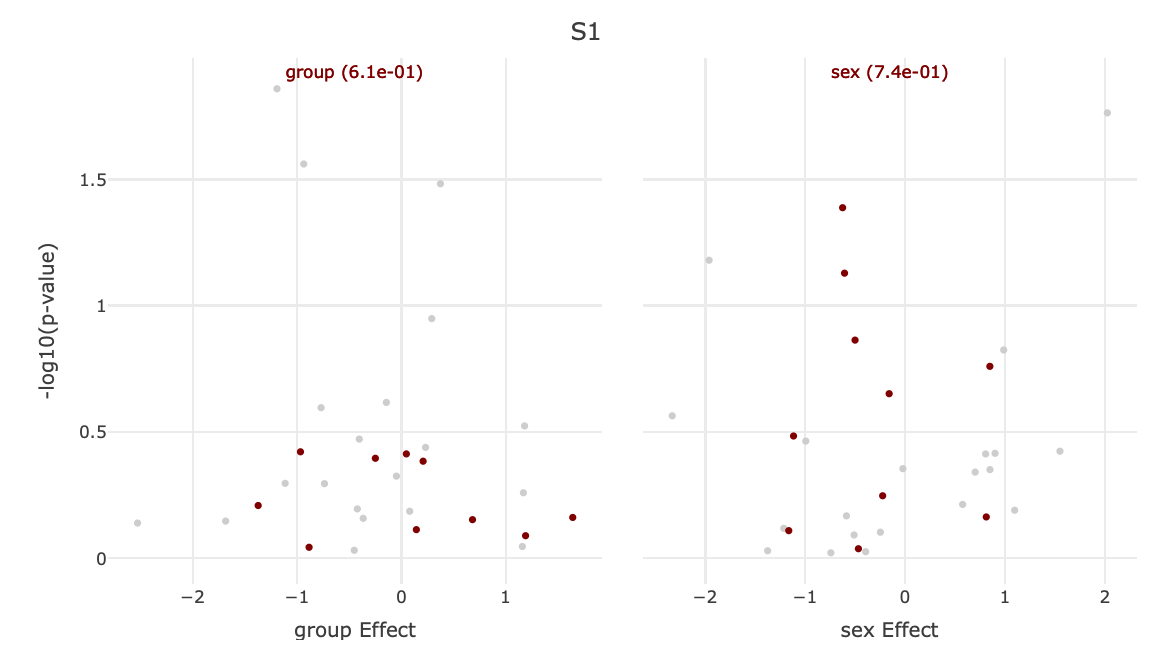一个R闪闪发光的应用程序,它同时显示ggplot情节和巧妙的情节。
我正在尝试建立一个R shiny app,它将允许查看与基因表达数据相关的三种类型的图表。
这些数据包括:
一个具有差异表达式分析输出的data.frame (每一行都是一个基因,列是效果大小及其p值):
set.seed(1)
model.df <- data.frame(id = paste0("g",1:30),symbol = sample(LETTERS[1:5],30,replace=T),
group.effect.size = rnorm(30), group.p.value = runif(30,0,1),
sex.effect.size = rnorm(30), sex.p.value = runif(30,0,1),
stringsAsFactors = F)一个具有研究设计的data.frame (每一行都是一个样本,列是与该示例相关联的因素):
set.seed(1)
design.df <- data.frame(group = c(rep("A",6),rep("B",6)), sex = rep(c(rep("F",3),rep("M",3)),2), replicate = rep(1:6,2)) %>%
dplyr::mutate(sample = paste0(group,".",sex,"_",replicate))
design.df$group <- factor(design.df$group, levels = c("A","B"))
design.df$sex <- factor(design.df$sex, levels = c("F","M"))一个具有丰富度的matrix (每一行都是一个基因,每一列都是一个样本):
set.seed(1)
abundance.mat <- matrix(rnorm(30*12), nrow=30, ncol=12, dimnames=list(model.df$id,design.df$sample))一个data.frame,它有一个基因集富集分析的结果(每一行都是一个集合名称,列是design.df中每个因素的富集测试p值):
set.seed(1)
gsea.df <- data.frame(set.name = paste0("S",1:4), group.p.value = format(round(runif(4,0,1),2),scientific = T), sex.p.value = format(round(runif(4,0,1),2),scientific = T), stringsAsFactors = F)最后,一个data.frame,它将基因与gsea.df中的每个set.name相关联。
set.seed(1)
gene.sets.df <- do.call(rbind,lapply(1:4,function(s) data.frame(set.name = paste0("S",s), id = sample(model.df$id,10,replace = F),stringsAsFactors = F)))我希望shiny app能够查看这些类型的情节:
Feature Plot-绘制单个用户选择的基因在y-axis上的表达水平和x-axis上的样本,并将其与显示估计效果的毛毛虫图内嵌物结合起来:

Feature User-Defined Sets Plot--与Feature Plot一样--然而,它将显示一组用户选择的基因,而不是显示单个-selected基因,因此它将显示出分布的微调:

Feature Sets GSEA Plot-火山图的组合列表,其中x-axis是因子的效果大小,y-axis是效果的-log10(p值),如果基因属于所选的基因集,则为红色:

以下是在用户选择的情况下生成这些数字的三个功能:
featurePlot <- function(selected.id)
{
replicate.df <- reshape2::melt(abundance.mat[which(rownames(abundance.mat) == selected.id),,drop=F], varnames=c("id","sample")) %>%
dplyr::left_join(design.df)
effects.df <- data.frame(factor.name = c("group","sex"),
effect.size = c(dplyr::filter(model.df,id == selected.id)$group.effect.size,dplyr::filter(model.df,id == selected.id)$sex.effect.size),
p.value = c(dplyr::filter(model.df,id == selected.id)$group.p.value,dplyr::filter(model.df,id == selected.id)$sex.p.value),
stringsAsFactors = F)
effects.df$factor.name <- factor(effects.df$factor.name, levels = c("group","sex"))
main.plot <- ggplot(replicate.df,aes(x=replicate,y=value,color=group,shape=sex))+
geom_point(size=3)+facet_grid(~group,scales="free_x")+
labs(x="Replicate",y="TPM")+theme_minimal()
xlims <- c(-1*max(abs(effects.df$effect.size))-0.1*max(abs(effects.df$effect.size)),max(abs(effects.df$effect.size))+0.1*max(abs(effects.df$effect.size)))
effects.plot <- ggplot(effects.df,aes(x=effect.size,y=factor.name,color=factor.name))+
geom_point()+
geom_vline(xintercept=0,linetype="longdash",colour="black",size=0.25)+theme_minimal()+xlim(xlims)+
theme(legend.position="none")+ylab("")+xlab("Effect Size")
null.plot <- ggplot(data.frame())+geom_point()+geom_blank()+theme_minimal()
combined.plot <- gridExtra::arrangeGrob(main.plot,gridExtra::arrangeGrob(null.plot,effects.plot,ncol=1),nrow=1,ncol=2,widths=c(5,2.5))
return(combined.plot)
}
featureSetPlot <- function(selected.ids)
{
replicate.df <- reshape2::melt(abundance.mat[which(rownames(abundance.mat) %in% selected.ids),,drop=F], varnames=c("id","sample")) %>%
dplyr::left_join(design.df)
replicate.df$replicate <- as.factor(replicate.df$replicate)
effects.df <- data.frame(factor.name = c("group","sex"),
effect.size = c(dplyr::filter(model.df,id %in% selected.ids)$group.effect.size,dplyr::filter(model.df,id %in% selected.ids)$sex.effect.size),
p.value = c(dplyr::filter(model.df,id %in% selected.ids)$group.p.value,dplyr::filter(model.df,id %in% selected.ids)$sex.p.value),
stringsAsFactors = F)
effects.df$factor.name <- factor(effects.df$factor.name, levels = c("group","sex"))
main.plot <- ggplot(replicate.df,aes(x=replicate,y=value,color=group,fill=sex))+
geom_violin(trim=F,draw_quantiles=c(0.25,0.5,0.75),alpha=0.25)+facet_grid(~group,scales="free_x")+
labs(x="Replicate",y="TPM")+theme_minimal()
effects.plot <- ggplot(effects.df,aes(y=effect.size,x=factor.name,color=factor.name,fill=factor.name))+
geom_violin(trim=F,draw_quantiles=c(0.25,0.5,0.75),alpha=0.25)+coord_flip()+
geom_hline(yintercept=0,linetype="longdash",colour="black",size=0.25)+theme_minimal()+
theme(legend.position="none")+xlab("")+ylab("Effect Size Distribution")
null.plot <- ggplot(data.frame())+geom_point()+geom_blank()+theme_minimal()
combined.plot <- gridExtra::arrangeGrob(main.plot,gridExtra::arrangeGrob(null.plot,effects.plot,ncol=1),nrow=1,ncol=2,widths=c(5,2.5))
return(combined.plot)
}
gseaPlot <- function(selected.set)
{
plot.df <- model.df %>%
dplyr::left_join(gene.sets.df %>% dplyr::filter(set.name == selected.set))
plot.df$set.name[which(is.na(plot.df$set.name))] <- "non.selected"
plot.df$set.name <- factor(plot.df$set.name, levels = c("non.selected",selected.set))
factor.names <- c("group","sex")
gsea.volcano.plot <- lapply(factor.names,function(f)
plotly::plot_ly(type='scatter',mode="markers",marker=list(size=5),color=plot.df$set.name,colors=c("lightgray","darkred"),x=plot.df[,paste0(f,".effect.size")],y=-log10(plot.df[,paste0(f,".p.value")]),showlegend=F) %>%
plotly::layout(annotations=list(showarrow=F,x=0.5,y=0.95,align="center",xref="paper",xanchor="center",yref="paper",yanchor="bottom",font=list(size=12,color="darkred"),text=paste0(f," (",dplyr::filter(gsea.df,set.name == selected.set)[,paste0(f,".p.value")],")")),
xaxis=list(title=paste0(f," Effect"),zeroline=F),yaxis=list(title="-log10(p-value)",zeroline=F))
) %>% plotly::subplot(nrows=1,shareX=F,shareY=T,titleX=T,titleY=T) %>%
plotly::layout(title=selected.set)
return(gsea.volcano.plot)
}因此:
plot.type.choices <- c('Feature User-Defined Set Plot','Feature Sets GSEA Plot','Feature Plot')所以前两个使用ggplot2来生成它们组合的两个数字中的每一个,然后使用gridExtra::arrangeGrob实现。最后一个使用plotly。
下面是我一直在尝试的shiny代码部分,但是没有结果:
server <- function(input, output)
{
out.plot <- reactive({
if(input$plotType == "Feature Plot"){
out.plot <- featurePlot(selected.id=dplyr::filter(model.df,symbol == input$symbol)$id[1])
} else if(input$plotType == "Feature User-Defined Set Plot"){
out.plot <- featureSetPlot(selected.ids=unique(dplyr::filter(model.df,symbol == input$set.symbols)$id))
} else if(input$plotType == "Feature Sets GSEA Plot"){
out.plot <- gseaVolcanoPlot(selected.set=input$set.name)
}
})
output$out.plot <- renderPlot({
if(input$plotType != "Feature Sets GSEA Plot"){
grid::grid.draw(out.plot())
} else{
out.plot()
}
})
output$save <- downloadHandler(
filename = function() {
paste0("./plot.pdf")
},
content = function(file) {
ggsave(out.plot(),filename=file,width=10,height=5)
}
)
}
ui <- fluidPage(
tags$style(type="text/css",".shiny-output-error { visibility: hidden; }",".shiny-output-error:before { visibility: hidden; }"),
titlePanel("Results Explorer"),
sidebarLayout(
sidebarPanel(
# select plot type
selectInput("plotType","Plot Type",choices=plot.type.choices),
#in case Feature User-Defined Set Plot was chosen select the genes
conditionalPanel(condition="input.plotType=='Feature User-Defined Set Plot'",
selectizeInput(inputId="set.symbols",label="Features Set Symbols",choices=unique(model.df$symbol),selected=model.df$symbol[1],multiple=T)),
#in case Feature Sets GSEA Plot was chosen select the databses
conditionalPanel(condition="input.plotType=='Feature Sets GSEA Plot'",
selectizeInput(inputId="set.name",label="Set Name",choices=unique(gene.sets.df$set.name),selected=gene.sets.df$set.name[1],multiple=F)),
#in case Feature Plot was chosen select the gene
conditionalPanel(condition="input.plotType=='Feature Plot'",
selectizeInput(inputId="symbol",label="Feature Symbol",choices=unique(model.df$symbol),selected=unique(model.df$symbol)[1],multiple=F)),
downloadButton('save', 'Save to File')
),
mainPanel(
plotOutput("output.plot")
)
)
)
shinyApp(ui = ui, server = server)我怀疑这里的renderPlot可能是问题所在,因为我可能不得不在Feature Sets GSEA Plot选项中使用plotly::renderPlotly,但我不太确定如何将其全部绑定到shiny server部分中。
另一个复杂的问题是,基因符号并不是唯一的WRT基因in (如model.df所示),这是一个很好的解决方案。因此,如果用户选择了Feature Plot选项,那么最好是添加一个列表,该列表将显示所选符号映射到的基因ID的子集(dplyr::filter(model.df == input$symbol)$id)。
谢谢!
回答 2
Stack Overflow用户
发布于 2019-05-03 13:13:32
我也猜问题是"renderPlot“。一种解决这个问题的不太优雅的方法是将一个输出分割成两个,但只使用"req()“显示其中的一个。
这段代码将成为:
output$out.plot <- renderPlot({
....
})这是:
output$out.plot1 <- renderPlot({
req(input$plotType != "Feature Sets GSEA Plot")
grid::grid.draw(out.plot())
})
output$out.plot2 <- renderPlotly({
req(input$plotType == "Feature Sets GSEA Plot")
out.plot()
})现在,您可以在UI中添加下面的情节。"req()“确保在语句中的语句不是”真实的“(请参见?req),在本例中为"TRUE”时,不绘制任何内容。用户不会看到这与像您尝试的那样替换一个输出之间的区别。
Stack Overflow用户
发布于 2019-05-07 18:00:50
以下是我自始至终的解决方案:
要装载的包:
suppressPackageStartupMessages(library(dplyr))
suppressPackageStartupMessages(library(ggplot2))
suppressPackageStartupMessages(library(plotly))
suppressPackageStartupMessages(library(shiny))生成示例数据:
set.seed(1)
model.df <- data.frame(id = paste0("g",1:30),symbol = sample(LETTERS[1:5],30,replace=T),
group.effect.size = rnorm(30), group.p.value = runif(30,0,1),
sex.effect.size = rnorm(30), sex.p.value = runif(30,0,1),
stringsAsFactors = F)
set.seed(1)
design.df <- data.frame(group = c(rep("A",6),rep("B",6)), sex = rep(c(rep("F",3),rep("M",3)),2), replicate = rep(1:6,2)) %>%
dplyr::mutate(sample = paste0(group,".",sex,"_",replicate))
design.df$group <- factor(design.df$group, levels = c("A","B"))
design.df$sex <- factor(design.df$sex, levels = c("F","M"))
set.seed(1)
abundance.mat <- matrix(rnorm(30*12), nrow=30, ncol=12, dimnames=list(model.df$id,design.df$sample))
set.seed(1)
gsea.df <- data.frame(set.name = paste0("S",1:4), group.p.value = format(round(runif(4,0,1),2),scientific = T), sex.p.value = format(round(runif(4,0,1),2),scientific = T), stringsAsFactors = F)
set.seed(1)
gene.sets.df <- do.call(rbind,lapply(1:4,function(s) data.frame(set.name = paste0("S",s), id = sample(model.df$id,10,replace = F),stringsAsFactors = F)))
plot.type.choices <- c("Feature Plot","User-Defined Feature Set Plot","Feature Sets GSEA Plot")绘图功能:
featurePlot <- function(selected.id)
{
replicate.df <- reshape2::melt(abundance.mat[which(rownames(abundance.mat) == selected.id),,drop=F], varnames=c("id","sample")) %>%
dplyr::left_join(design.df)
effects.df <- data.frame(factor.name = c("group","sex"),
effect.size = c(dplyr::filter(model.df,id == selected.id)$group.effect.size,dplyr::filter(model.df,id == selected.id)$sex.effect.size),
p.value = c(dplyr::filter(model.df,id == selected.id)$group.p.value,dplyr::filter(model.df,id == selected.id)$sex.p.value),
stringsAsFactors = F)
effects.df$factor.name <- factor(effects.df$factor.name, levels = c("group","sex"))
main.plot <- ggplot(replicate.df,aes(x=replicate,y=value,color=group,shape=sex))+
geom_point(size=3)+facet_grid(~group,scales="free_x")+
labs(x="Replicate",y="TPM")+theme_minimal()
xlims <- c(-1*max(abs(effects.df$effect.size))-0.1*max(abs(effects.df$effect.size)),max(abs(effects.df$effect.size))+0.1*max(abs(effects.df$effect.size)))
effects.plot <- ggplot(effects.df,aes(x=effect.size,y=factor.name,color=factor.name))+
geom_point()+
geom_vline(xintercept=0,linetype="longdash",colour="black",size=0.25)+theme_minimal()+xlim(xlims)+
theme(legend.position="none")+ylab("")+xlab("Effect Size")
null.plot <- ggplot(data.frame())+geom_point()+geom_blank()+theme_minimal()
combined.plot <- gridExtra::arrangeGrob(main.plot,gridExtra::arrangeGrob(null.plot,effects.plot,ncol=1),nrow=1,ncol=2,widths=c(5,2.5))
return(combined.plot)
}
featureSetPlot <- function(selected.ids)
{
replicate.df <- reshape2::melt(abundance.mat[which(rownames(abundance.mat) %in% selected.ids),,drop=F], varnames=c("id","sample")) %>%
dplyr::left_join(design.df)
replicate.df$replicate <- as.factor(replicate.df$replicate)
effects.df <- data.frame(factor.name = c("group","sex"),
effect.size = c(dplyr::filter(model.df,id %in% selected.ids)$group.effect.size,dplyr::filter(model.df,id %in% selected.ids)$sex.effect.size),
p.value = c(dplyr::filter(model.df,id %in% selected.ids)$group.p.value,dplyr::filter(model.df,id %in% selected.ids)$sex.p.value),
stringsAsFactors = F)
effects.df$factor.name <- factor(effects.df$factor.name, levels = c("group","sex"))
main.plot <- ggplot(replicate.df,aes(x=replicate,y=value,color=group,fill=sex))+
geom_violin(trim=F,draw_quantiles=c(0.25,0.5,0.75),alpha=0.25)+facet_grid(~group,scales="free_x")+
labs(x="Replicate",y="TPM")+theme_minimal()
effects.plot <- ggplot(effects.df,aes(y=effect.size,x=factor.name,color=factor.name,fill=factor.name))+
geom_violin(trim=F,draw_quantiles=c(0.25,0.5,0.75),alpha=0.25)+coord_flip()+
geom_hline(yintercept=0,linetype="longdash",colour="black",size=0.25)+theme_minimal()+
theme(legend.position="none")+xlab("")+ylab("Effect Size Distribution")
null.plot <- ggplot(data.frame())+geom_point()+geom_blank()+theme_minimal()
combined.plot <- gridExtra::arrangeGrob(main.plot,gridExtra::arrangeGrob(null.plot,effects.plot,ncol=1),nrow=1,ncol=2,widths=c(5,2.5))
return(combined.plot)
}
gseaPlot <- function(selected.set)
{
plot.df <- model.df %>%
dplyr::left_join(gene.sets.df %>% dplyr::filter(set.name == selected.set))
plot.df$set.name[which(is.na(plot.df$set.name))] <- "non.selected"
plot.df$set.name <- factor(plot.df$set.name, levels = c("non.selected",selected.set))
factor.names <- c("group","sex")
gsea.plot <- lapply(factor.names,function(f)
plotly::plot_ly(type='scatter',mode="markers",marker=list(size=5),color=plot.df$set.name,colors=c("lightgray","darkred"),x=plot.df[,paste0(f,".effect.size")],y=-log10(plot.df[,paste0(f,".p.value")]),showlegend=F) %>%
plotly::layout(annotations=list(showarrow=F,x=0.5,y=0.95,align="center",xref="paper",xanchor="center",yref="paper",yanchor="bottom",font=list(size=12,color="darkred"),text=paste0(f," (",dplyr::filter(gsea.df,set.name == selected.set)[,paste0(f,".p.value")],")")),
xaxis=list(title=paste0(f," Effect"),zeroline=F),yaxis=list(title="-log10(p-value)",zeroline=F))
) %>% plotly::subplot(nrows=1,shareX=F,shareY=T,titleX=T,titleY=T) %>%
plotly::layout(title=selected.set)
return(gsea.plot)
}服务器:
server <- function(input, output)
{
out.plot <- reactive({
if(input$plotType == "Feature Plot"){
out.plot <- featurePlot(selected.id=dplyr::filter(model.df,symbol == input$symbol)$id[1])
} else if(input$plotType == "User-Defined Feature Set Plot"){
out.plot <- featureSetPlot(selected.ids=unique(dplyr::filter(model.df,symbol == input$set.symbols)$id))
} else if(input$plotType == "Feature Sets GSEA Plot"){
out.plot <- gseaPlot(selected.set=input$set.name)
}
})
output$feature.plot <- renderPlot({
req(input$plotType == "Feature Plot")
grid::grid.draw(out.plot())
})
output$user.defined.feature.set.plot <- renderPlot({
req(input$plotType == "User-Defined Feature Set Plot")
grid::grid.draw(out.plot())
})
output$feature.set.gsea.plot <- renderPlotly({
req(input$plotType == "Feature Sets GSEA Plot")
out.plot()
})
output$save <- downloadHandler(
filename = function() {
paste0("./plot.pdf")
},
content = function(file) {
if(input$plotType != "Feature Sets GSEA Plot"){
ggsave(out.plot(),filename=file,width=10,height=5)
} else{
plotly::export(out.plot(),file=file)
}
}
)
}UI:
ui <- fluidPage(
tags$style(type="text/css",".shiny-output-error { visibility: hidden; }",".shiny-output-error:before { visibility: hidden; }"),
titlePanel("Results Explorer"),
sidebarLayout(
sidebarPanel(
# select plot type
selectInput("plotType","Plot Type",choices=plot.type.choices),
#in case User-Defined Feature Set Plot was chosen select the genes
conditionalPanel(condition="input.plotType == 'User-Defined Feature Set Plot'",
selectizeInput(inputId="set.symbols",label="Features Set Symbols",choices=unique(model.df$symbol),selected=model.df$symbol[1],multiple=T)),
#in case Feature Sets GSEA Plot was chosen select the databses
conditionalPanel(condition="input.plotType == 'Feature Sets GSEA Plot'",
selectizeInput(inputId="set.name",label="Set Name",choices=unique(gene.sets.df$set.name),selected=gene.sets.df$set.name[1],multiple=F)),
#in case Feature Plot was chosen select the gene
conditionalPanel(condition="input.plotType == 'Feature Plot'",
selectizeInput(inputId="symbol",label="Feature Symbol",choices=unique(model.df$symbol),selected=unique(model.df$symbol)[1],multiple=F)),
downloadButton('save', 'Save to File')
),
mainPanel(
conditionalPanel(
condition = "input.plotType == 'User-Defined Feature Set Plot'",
plotOutput("user.defined.feature.set.plot")
),
conditionalPanel(
condition = "input.plotType == 'Feature Sets GSEA Plot'",
plotly::plotlyOutput("feature.set.gsea.plot")
),
conditionalPanel(
condition = "input.plotType == 'Feature Plot'",
plotOutput("feature.plot")
)
)
)
)呼叫:
shinyApp(ui = ui, server = server)https://stackoverflow.com/questions/55961021
复制相似问题

